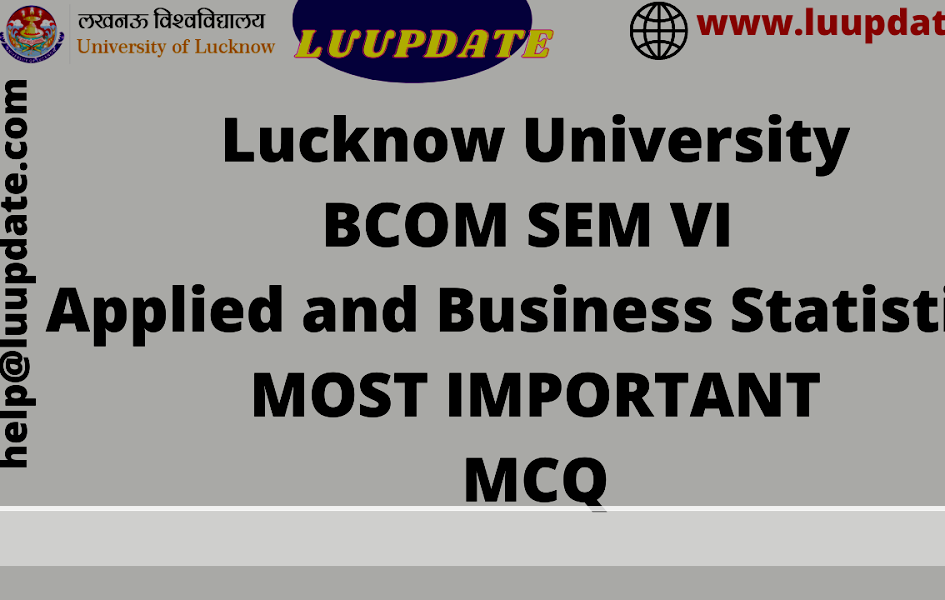Most Important MCQs On APPLIED AND BUSINESS STATISTICS For BCOM SEM VI
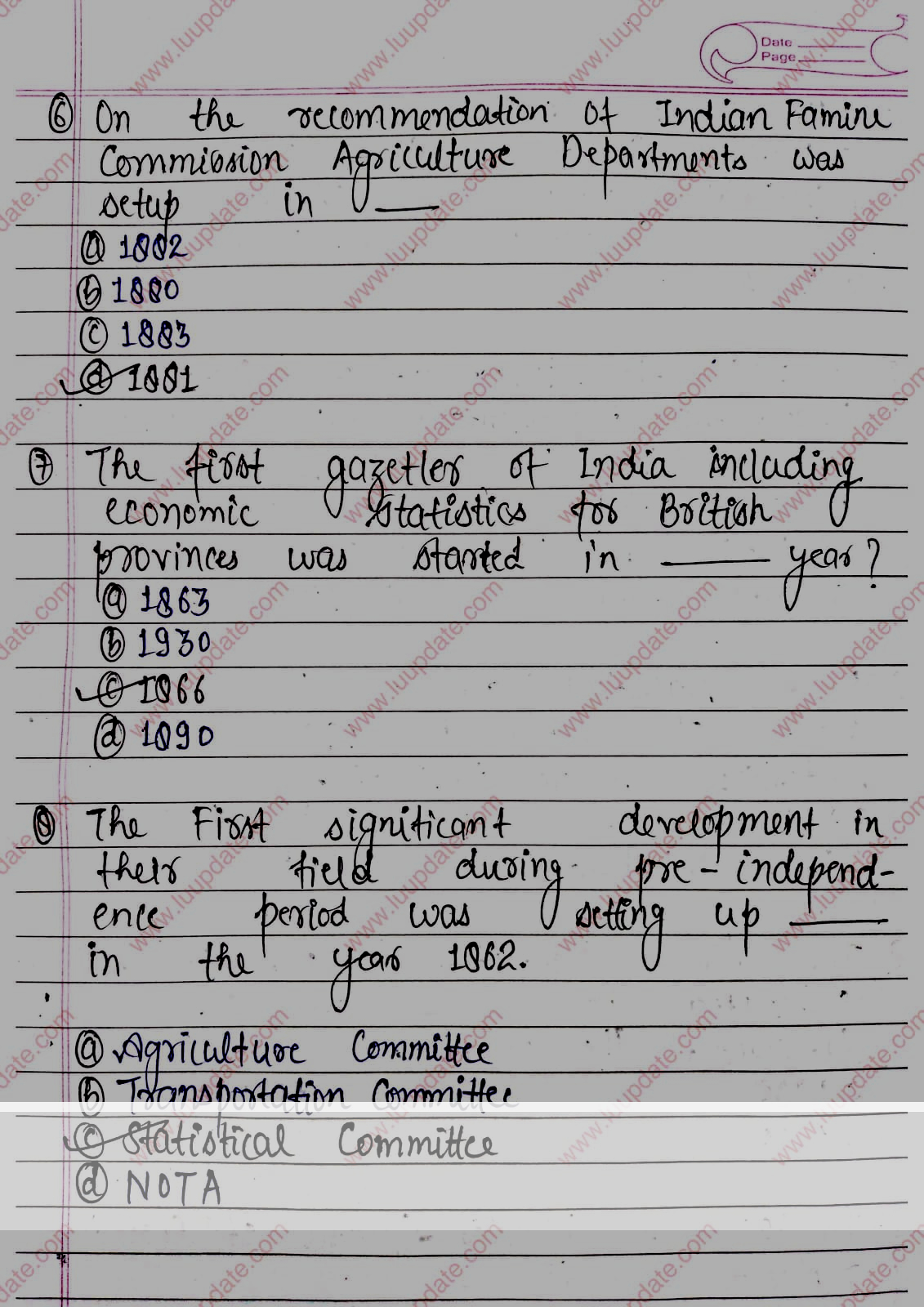
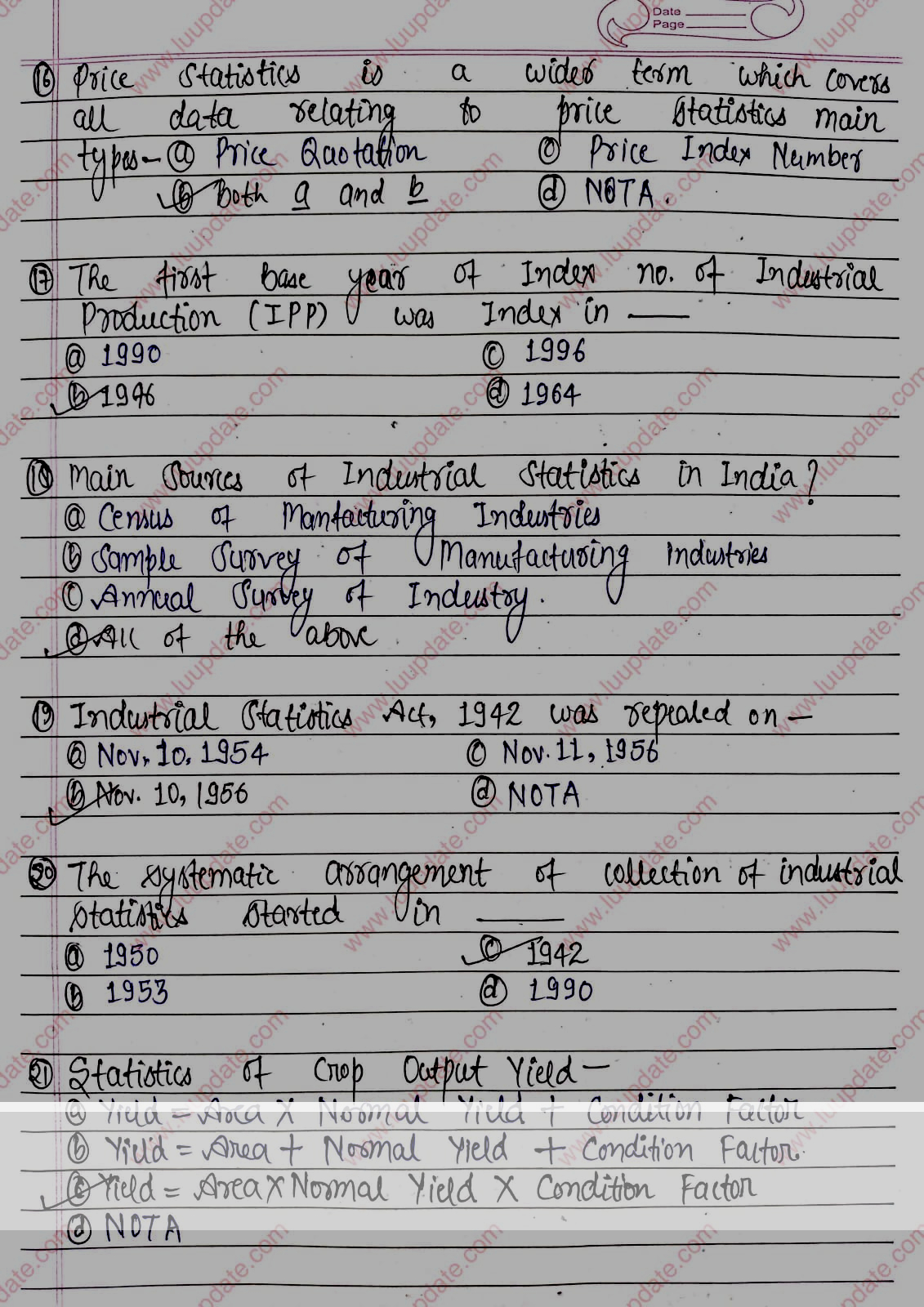
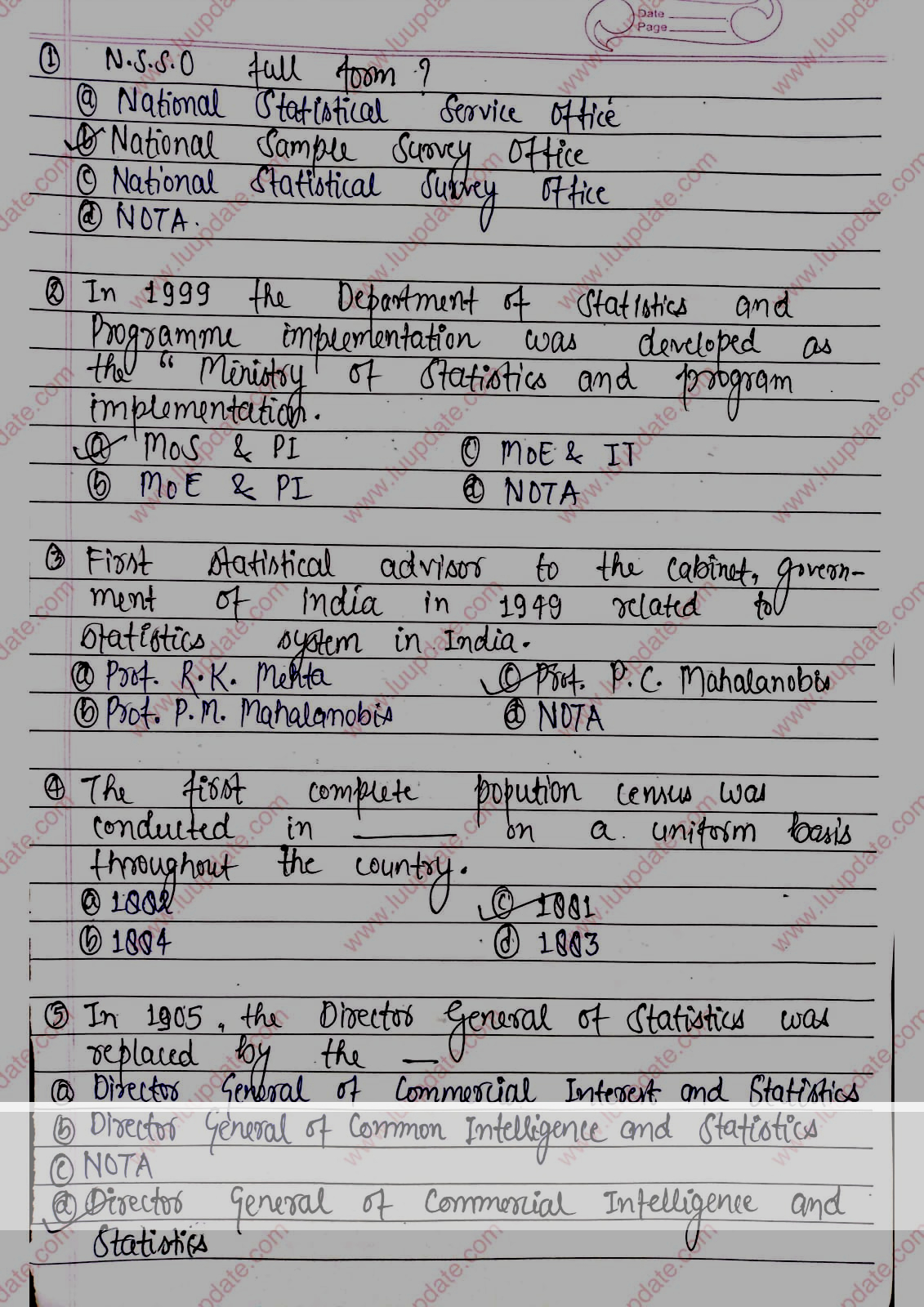
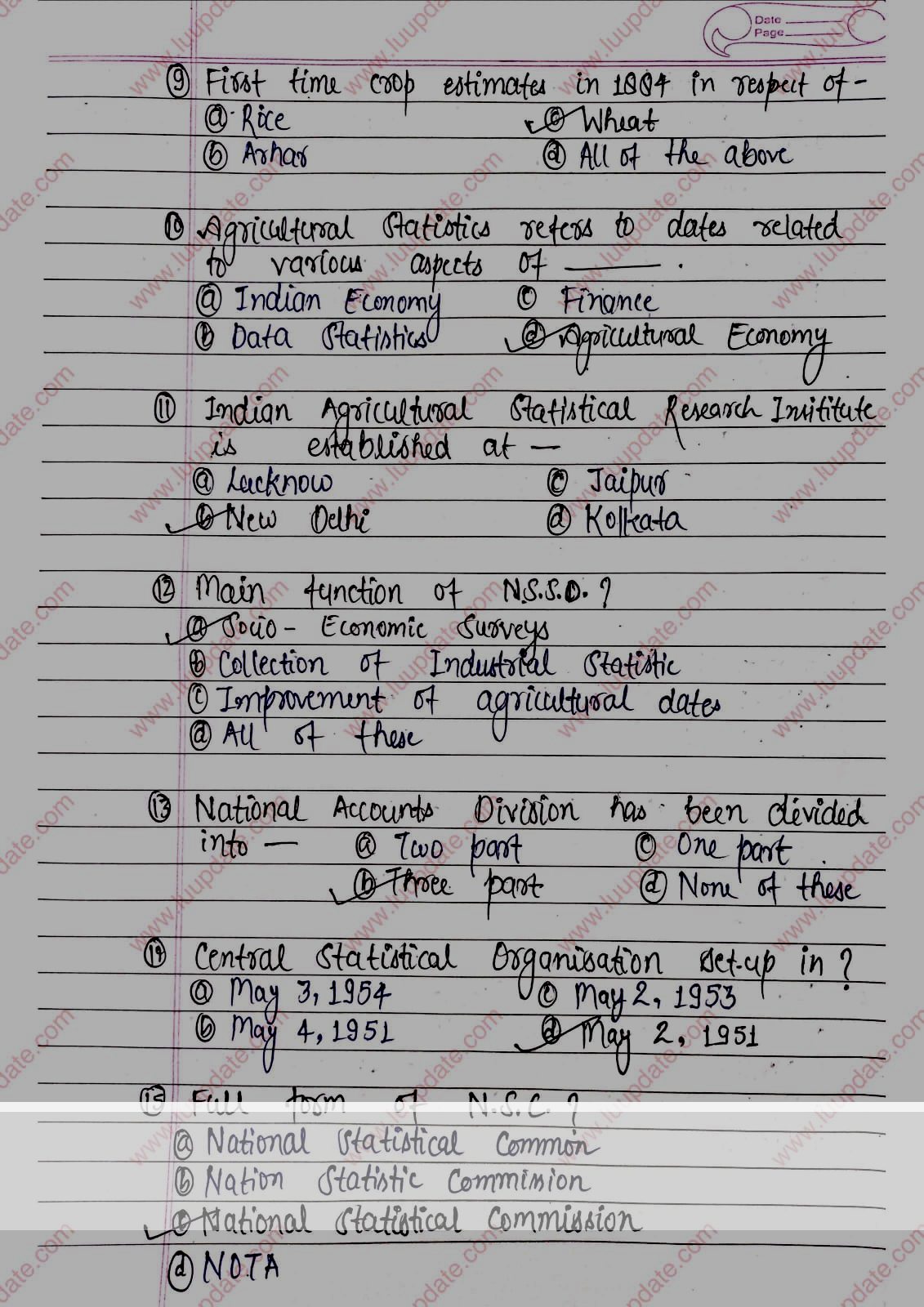

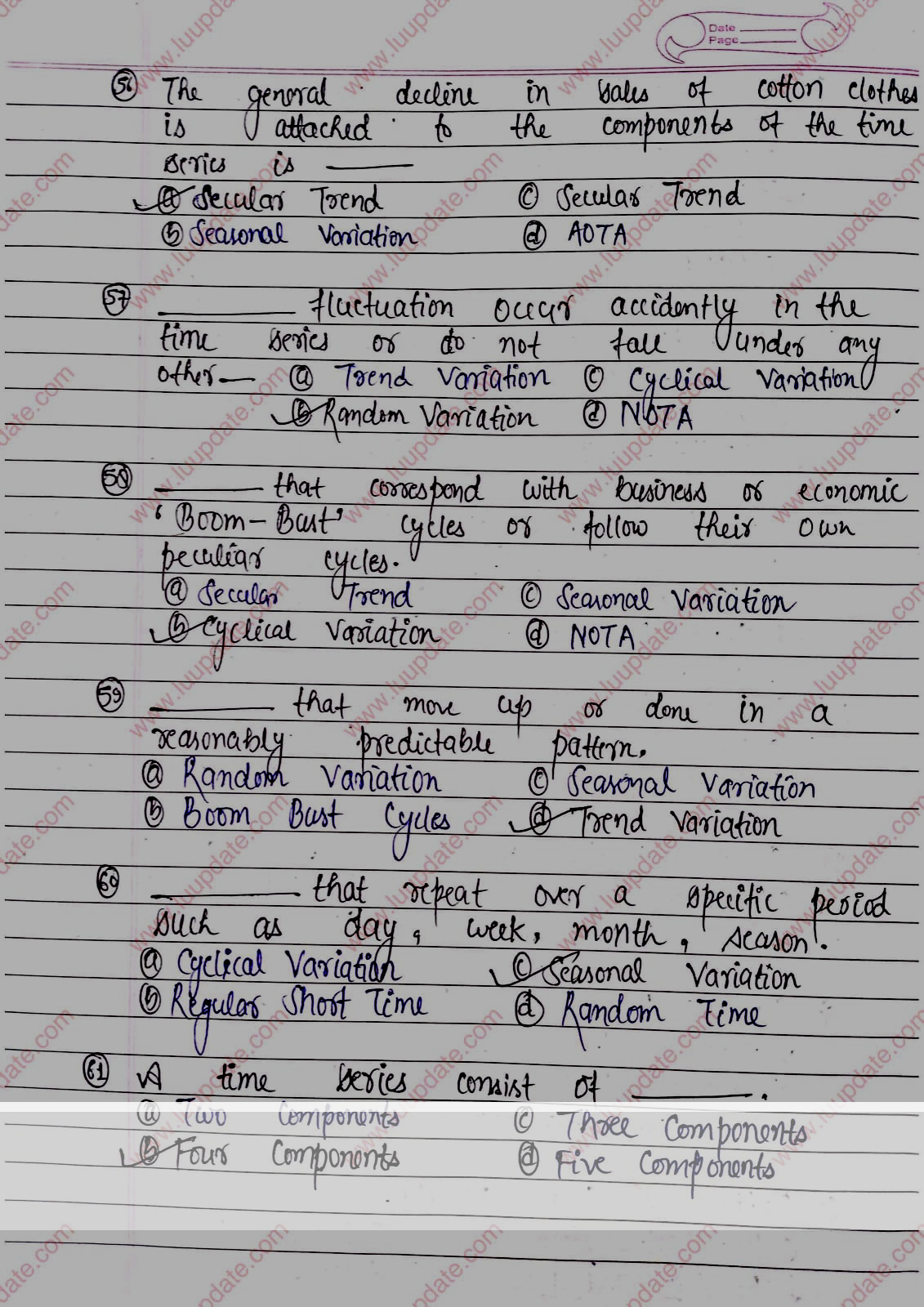
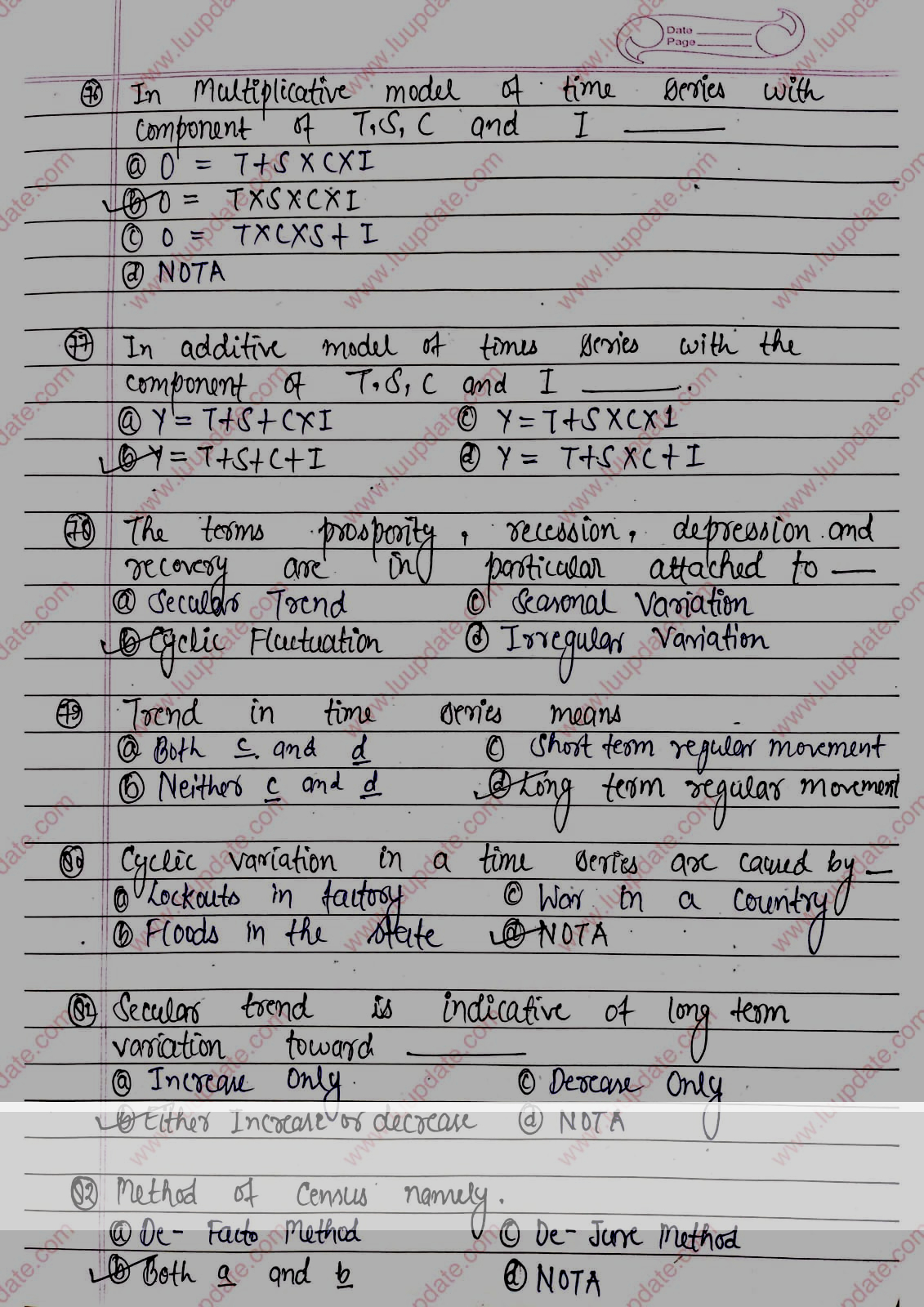

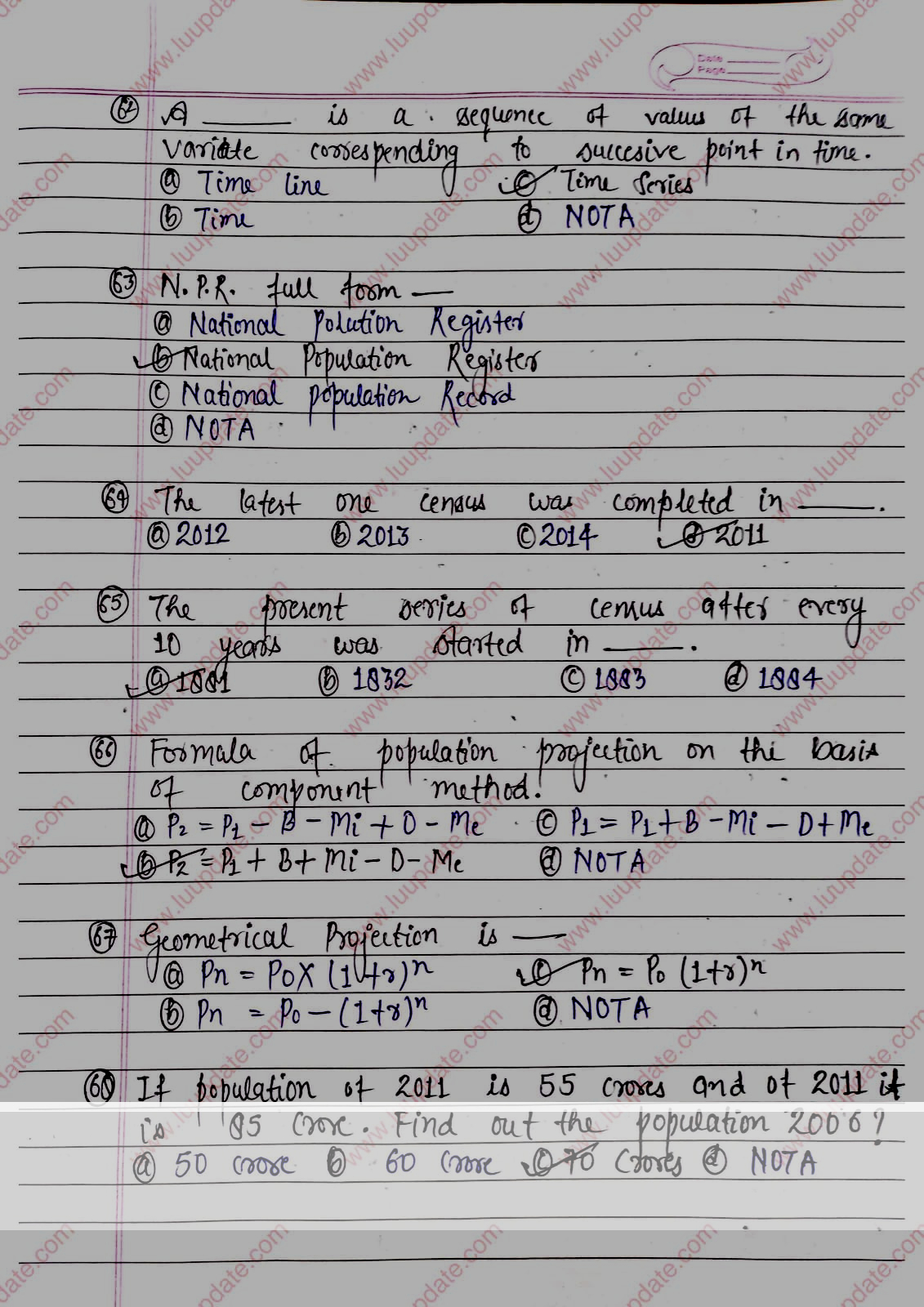
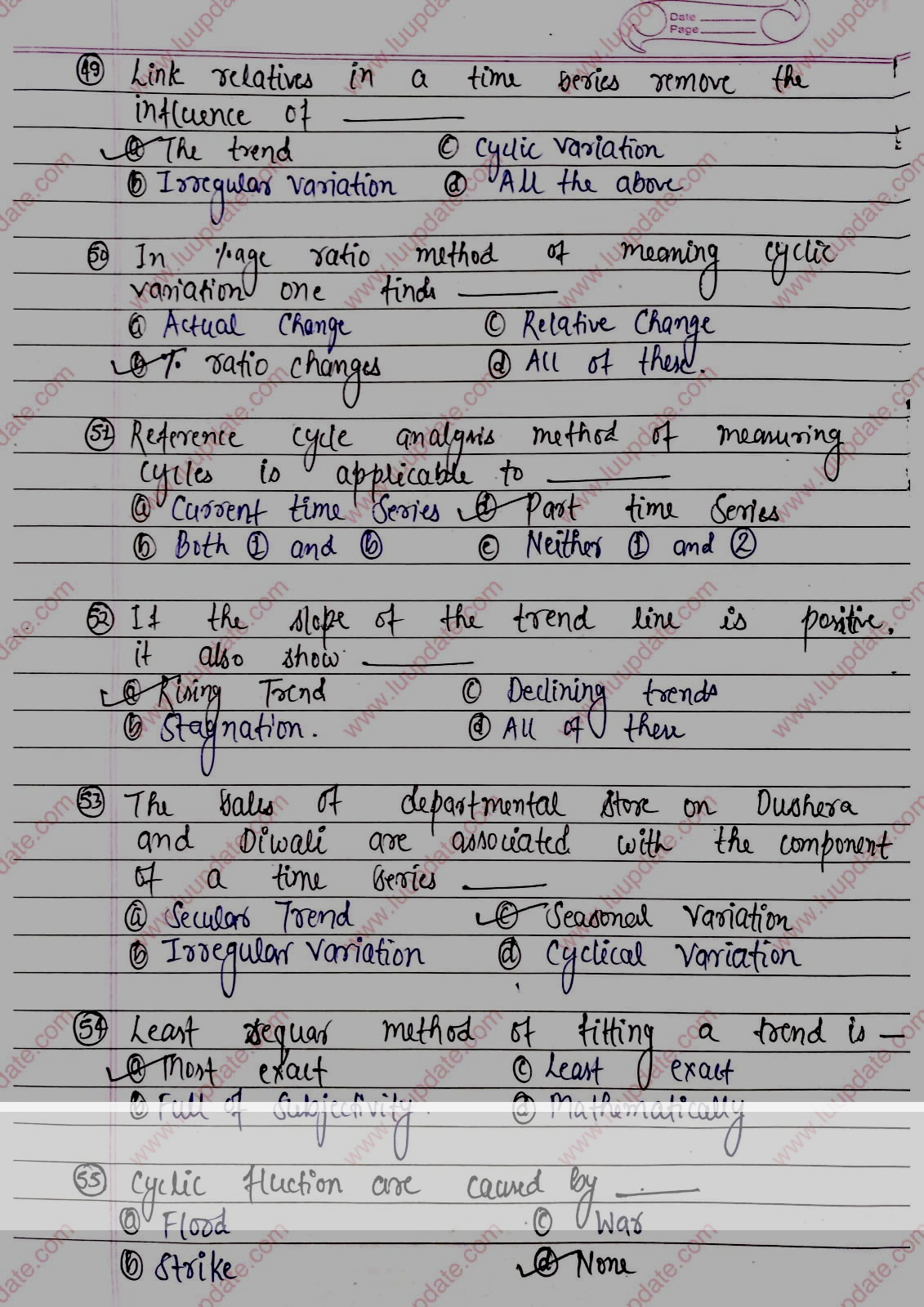
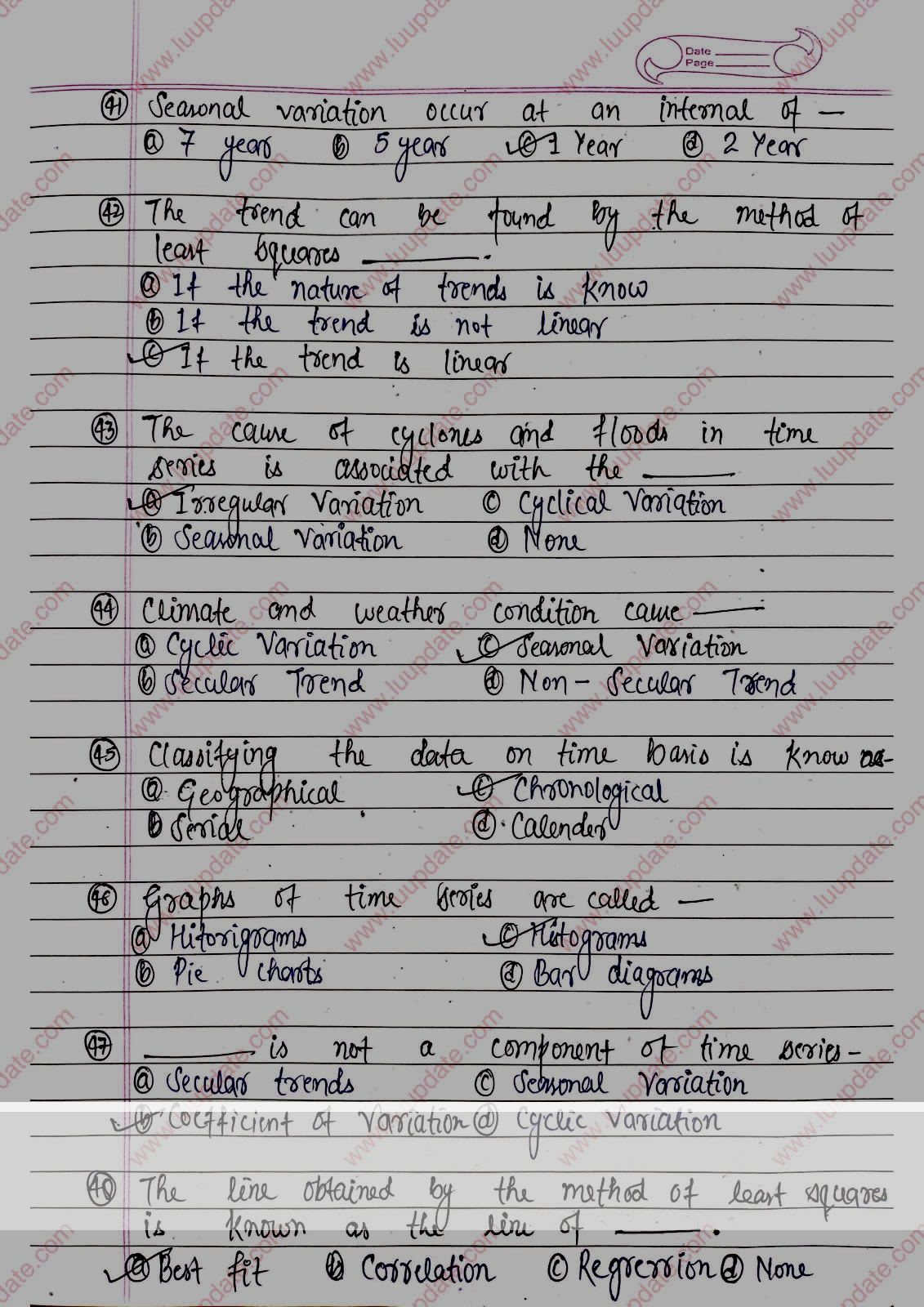
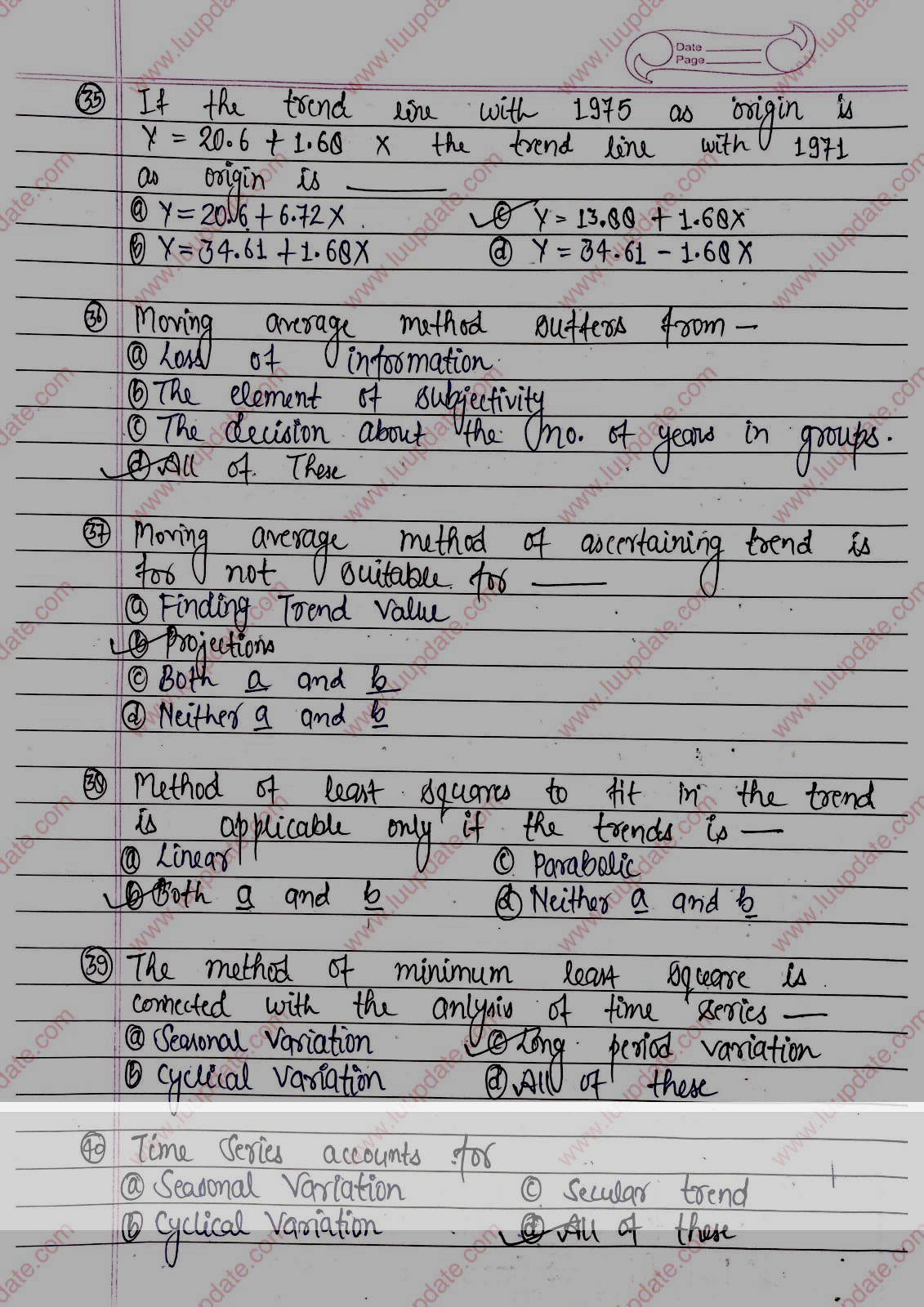
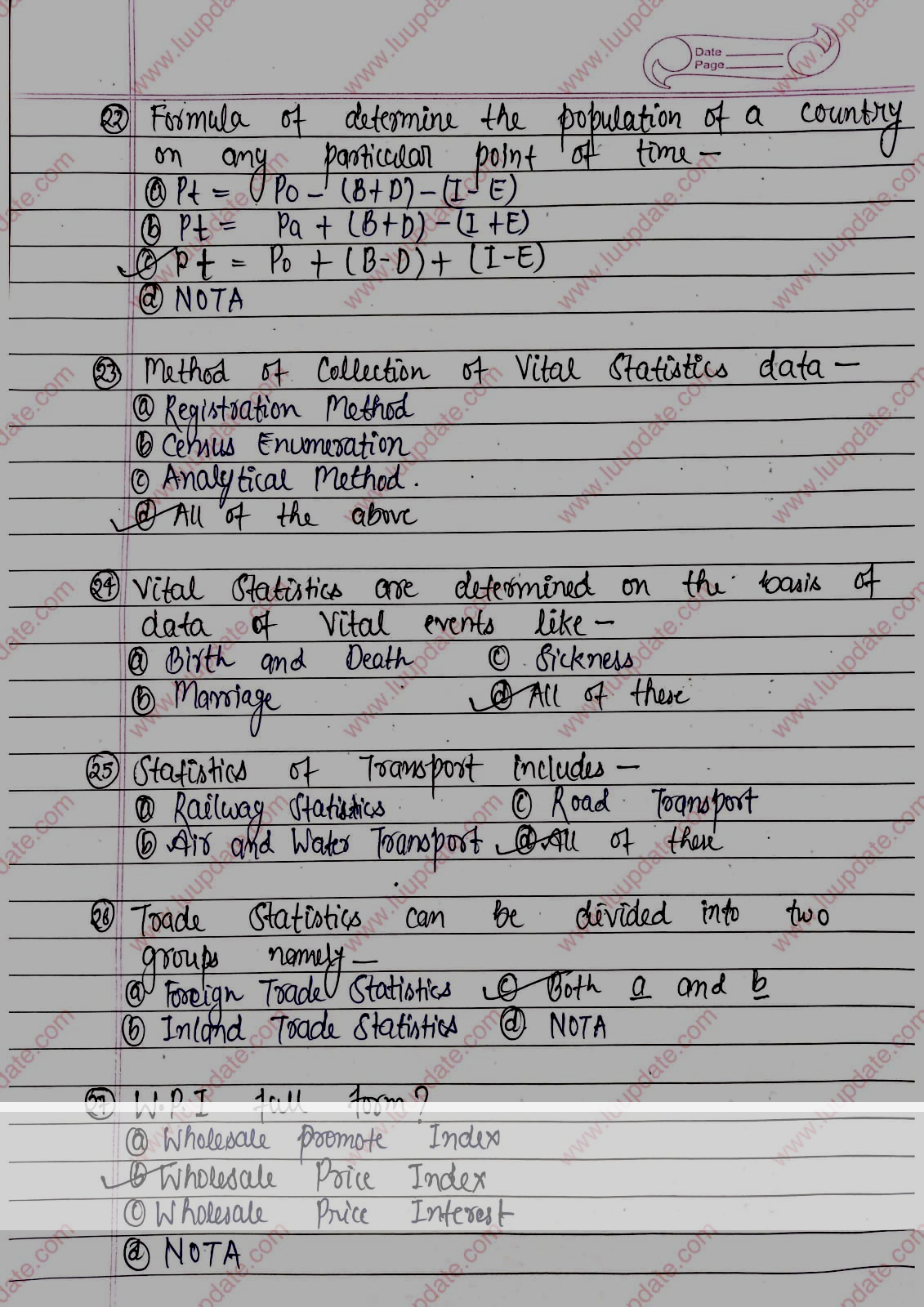


The ratio of a sum of prices ill current period to the sum of prices ill the base period, expressed as a percentage is called
(a) Simple price index number
(b) Simple aggregative price index number
(c) Weighted aggregative price index number
(d) Quantity index number
2. Fiber’s Ideal index number satisfies :
(a) Time Reversal Test only
(b) Factor Reversal Test only
(C) Time & Factor Reversal Tests
(d) None of these
3. The suitable index number for the comparison of changes in price level every year is
(a) Fixed base index number based on Average prices
b) Chain Base index numbers
c). Single year fixed base index numbers
d) None of these
4. Geometric mean is most suitable as a meas of price relatives because it
(a) Satisfies all reversal tests
(b) Gives less weight to small terms and more weight to big terms
C)Gives equal weights to equal ratios of changes in prices
d) None of these
5. The most suitable index number for the study of changes in price level influencing a particular class of society is:
a. Wholesale Price Index No.
b. Cost of Living Index No.
c. Quantity Index No.
d. None of these
6. If with an increase of 10% in prices the wages are increased by 20%, the real wages increase is by:
a. 10%
b. More than 10%
c. Less than 10%
d. None of these
7. Theoretically, the best average in the construction of index numbers is:
a. Arithmetic Mean
b. Median
c. Harmonic Mean
d. Geometric Mean
8. Laspeyre’s index is based on:
A. Base Year Quantities
B. Current Year Quantities
C. Average of Base and Current Year
D. None of these
9. Fisher’s ideal index is:
a. Arithmetic mean of Laspeyre’s and Paasche’s index
b. Harmonic mean of Lagpeyre’s and Paasche’s index
c. Geometric mean of Laspeyre’s and Paasche’s index
d. None of these
14. If all the values are of equal importance, the index numbers are called:
(a) Weighted
(b) Unweighted
(c)Composite
(d) Value index
15. Index numbers can be used for:
(a) Forecasting
(b) Fixed prices
(c) Different prices
(d) Constant prices
16. Index for base period is always taken as:
(a) 100
(b) One
(c) 200
(d) Zero
17. When the prices of rice are to be compared, we compute:
(a) Volume index
(b) Value index
(c) Price index
(d) Aggregative index
18. When index number is calculated for several variables, it is called:
(a) Composite index
(b) Whole sale price index
(c) Volume index
(d) Simple index
19. In chain base method, the base period is:
(a) Fixed
(b) Not fixed
(c) Constant
(d) Zero
20. Price relatives are a percentage ratio of current year price and:
(a) Base year quantity
(b) Previous year quantity
(c) Base year price
(d) Current year quantity
21. An index number that can serve many purposes is called:
(a) General purpose index
(b) Special purpose index
(c) Cost of living index
(d) None of them
22 Another name of consumer’s price index number is:
(a) Whole-sale price index number
(b) Cost of living index
(c) Sensitive
(d) Composite
23. Consumer price index indicates:
(a) Rise
(b) Fall
(c) Both (a) and (b)
(d) Neither (a) and (b)
24. Purchasing power of money can be accessed through:
(a) Simple index (b) Fisher’s index (c) Consumer price index (d) Volume index
25. Index number having upward bias is:
(a) Laspeyre’s index (b) Paasche’s index (c) Fisher’s ideal index (d) Marshal Edgworth index
26. Marshall Edgeworth price index was proposed by:
(a) One English economist (b) Two English economist
(c) Three English economist (d) Many English economist
27. Index number calculated by Fisher’s formula is ideal because it satisfy:
(a) Circular test (b) Factor reversal test (c) Time reversal test (d) All of the above
28. The test which is lot obeyed by any of the weighted index numbers weights are constant:
(a) Circular test (b) Time reversal test (c) Factor reversal test (d) None of them
29. Paasche’s price index number is also called:
(a) Base year weighted (b) Current year weighted (c) Simple aggregative index (d) Consumer price index
30. Laspeyre’s price index number is also called:
(a) Base year weighted (b) Current year weighted (c) Cost of living index (d) Simple aggregative index
31. Consumer price index are obtained by:
(a) Paasche’s formula (b) Fisher’s ideal formula (c) Marshall Edgeworth formula (d) Family budget method formula
32. Laspeyre’s index = 110, Paasche’s index = 108, then Fisher’s Ideal i’ to:
(a) 110
b) 108
(c) 100
(d) 109
34. The general purchasing power of the currency of a country is determined by:
(a) Retail price index
(b) Volume index
C)Composite index
(d) Whole-sale price index
35. What type of index number can help the government to formulate its price policies and to take appropriate economic measures to control prices:
(a) Whole sale price index
(b) Consumer’s price
(c) Quantity
(d) None of them
36. While computing a weighted index, the current period quantities are used in the:
(a) Laspeyre’s method
(b) Paasche’s method
(c) Marshall Edgeworth method
(d) Fisher’s ideal method
37. The best method to measure the relative change in prices of commoditie
(a) Quantity index number
(b) Value index number
(c) Volume index number
(d) Price index number
38. A time series consist of
a. Two components.
b. Three components.
c. Four components.
d. Five components.
39. The general decline in sales of cotton clothes is attached to the component of the time series is
a. Secular trend.
b. Cyclical variation.
c. Seasonal variation.
d. All of the above.
40. Secular trend is indicative of long term variation towards
a. Increase only.
b. Decrease only.
s. Either increase or decrease.
d. None of the above.
41. Method of least squares to fit in the trend is applicable only if the trend is
a. Linear
b. Parabolic
c. Both (a) and (b).
d. Neither (a) nor (b).
42. Cyclic variations in a time series are caused by
a. Lockouts in a factory.
b. War in a country.
c. Floods in the states.
d. None of the above.
43. Trend in a time series means_
a. Long term regular movement.
b. Short term regular movement.
c. Both (a) and (b).
D. Neither (a) nor (b).
44. The terms prosperity, recession, depression and recovery are in particular attached to
a. Secular trend.
b. Seasonal fluctuations.
c. Cyclic movements.
d. Irregular variations.
46. An additive model of time series with the components T, S, C and is
a. Y=T+S+C*I.
b. Y=T+S*C*1.
c. Y=T+S+C+l.
d. Y=T+S*C+l.
47. Moving average method of ascertaining trend is not suitable for
a. Finding trend values.
b. Projections.
c. Both (1) and (2).
d. Neither (1) nor (2).
48. Moving average method suffers from
a. Loss of information.
b. The element of subjectivity.
c. The decision about the number of years in groups.
d. All of the above.
49. Link relatives in a time series remove the influence of
a. The trend.
b. Cyclic variation.
c. Irregular variations.
d. All the above.
50. In percentage ratio method of measuring cyclic variations one finds_
a. Actual changes.
b. Relative changes.
c. Percent ratio changes.
d. All the above.
51. The cause of cyclones and floods in time series is associated with the
a. Irregular variation.
b. Cyclical variation.
c. Seasonal variation.
d. None of the above.
52. Reference cycle analysis method of measuring cycles is applicable to
a. Current time series.
b. Past time series.
c. Both (1) and (2).
d. Neither (1) nor (2).
53. To which component of the time series, the term recession is attached?
a. Trend.
b. Seasonal.
c. Cycles.
d. Random variation.
54. If the slope of the trend line is positive, it shows_
a. Rising trend.
b. Declining trend.
c. Stagnation.
d. All of the above.
55. The sales of a departmental store on Dushera and Diwali are associated With the component of a time series
a.Secular trend.
b. Seasonal variation.
C. Irregular variation.
d. Cyclical variation.
56. Least square method of fitting a trend is_
a. Most exact.
b. Least exact.
c. Full of subjectivity.
d. Mathematically unsound.
57. If the trend line with 1975 as origin is Y = 20.6 + 1.68X, the trend line with 1971 as origin is_
a. Y = 20.6+ 6.72X.
b. Y= 13.88 +1.68X.
c. Y34.61 +1.68X.
d. Y= 34.61+ 1.68X.
1. What does QA and QC stand for?
Quality Assurance and Queuing Control
Quality Adjustment and Quality completion
Quality Assurance and Quality control
Quality Adjustment and Queuing control
2. What is QA?
It is the measurement of degree to which a product satisfies the need
Any systematic process used to ensure quality in the process
Process of identifying defects
It is a corrective tool
3. Which of the following option is correct regarding QA and QC?
A QC is an integral part of QA
QA is an integral part of QC
QA and QC are independent to each other
QC may or may not depend on QA
4. LCL for the R chart is given by
D3 R
D2 B
R-D3 R
d2 R
In phase I application of x and R chart, the control limits obtained from the equations are treated as
Final limits
Trial limits
Warning limits
Pattern limits
6. The process standard deviation is given by
R/d2
Rd2
1/d2
None of these
7. Is there any relationship between specification limits and control limits of x and R charts?
Yes, Specification limits = Control limits
Yes Control limits Specification limits/2
No
Yes, Control limits 0.5= Specification limits
8. Control limits are
Limits defined by customer
Limits driven by the natural variability of the process
Limits driven by the inherent variability of the process Statistical limits
the natural variability of the process is measured by
Process mean
Sample standard deviation
Process standard deviation
Sample mean
10. What is the first step of QA?
Development of standards
Identification of customer need
Servicing
Material contro
11. What type of chart will be used to plot the number of defectives in the output of any process?
x bar chart
R chart
c chart
p chart
12. A tolerance diagram is also called
Scatter diagram
Defect concentration diagram
Tier chart
Histogram
16. The process of using the present and past conditions for analyzing future aspects is classified as
⚫ forecasting
⚫ term analysis
expectations analysis
⚫all of the above
17. Estimate of future condition on the basis of scientific analysis of available knowledge and information related to past Trend, present future condition and expected possibilities of business activity is know as:
Statistics
Business forecasting
Term analysis
None
18. Aspects of Business forecasting are:
historical analysis of time series
analysis of frequency distribution
analysis of current economic condition
All of these
25. A graphic method of studying dispersion is called:
Lorenz curve
Pareto curve
Income curve
None of these
26. Lorenz is also know as:
Economics curve
Expenditure curve
Dispersion curve
None
27. Lorenz curve was devised by:
Marshall
Ricardo
Adam Smith
Dr. Max O’Lorenz
31. A growing country is one whose
(a) GNP is rising at current prices
(b) GNP is constant at constant prices
(c) GNP is rising at constant prices
(d) None of these
32 factor cost is greater than Indirect taxes Market Prices, it means that
a) Indirect taxes subsidies subsidies
B)Indirect taxes subsidies subtitle
(d) None
33. Commodity service method’ is another name for:
(a) Expenditure method
(b) Income method
(c) Value-added Method
(d) None of these
34. Which Ministry is responsible for calculating GDP in India?
A) Ministry of Finance
(B) Ministry of Commerce and Industry
C)Ministry of Central Statistical and Program Implementation
D) Ministry of consumer Affairs
35. National Income differs from Net National Product at market price by the amount of:
(a) Current transfers from rest of the world
(b) Net Indirect Taxes
(c) National debt interest
(d) it does not differ
36.GDP /MP GDP +
(a) Depreciation
(b) Indirect taxes
(c) NFIA
(d) Subsidies
37. The difference between value of output and value added is:
(a)Depreciation
(b)Intermediate consumption
(c)Net indirect taxes
(d) NFIA
38. Product method of calculating national income is also known as:
(a)Income method
(b)Value added method
(c) Expenditure method
(d) Distribution method
39Transfer payments refer to payments, which are made:
a) Without any exchange of goods and services
(b) To workers on transfer from one job to another
(c)As compensation to employees
(d)None

